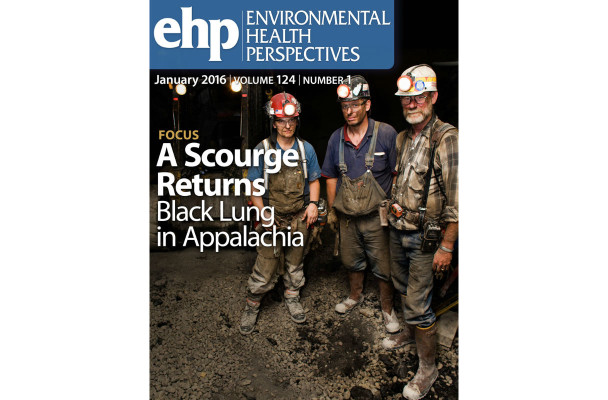Environmental Health Perspectives publishes article: “A Scourge Returns: Black Lung in Appalachia”

The resurgence of black lung has made the cover of Environmental Health Perspectives, a widely-read journal published by the U.S. Department of Health and Human Services.
The article, “A Scourge Returns: Black Lung in Appalachia” (pdf embedded below) by Carrie Arnold combines a personal look at the members of the Fayette County Black Lung Association in West Virginia with an overview of the history and science behind black lung. The article pays particular attention to the epidemiological literature showing the modern resurgence of black lung and the factors that researchers suspect contribute to the surge of aggressive black lung among recent miners: dust fraud by coal companies, a more toxic mix of dust due to mining thinner seams of coal with more pyrite, and longer working hours.
As the article explains:
For the NIOSH scientists, perhaps the most frustrating part of seeing these numbers was knowing it didn’t have to be this way. “Coal workers’ pneumoconiosis is an entirely preventable disease. They wouldn’t have gotten sick without inhaling way too much coal dust,” says NIOSH coauthor A. Scott Laney.
To the miners of the Fayette County Black Lung Association, the resurgence was no mystery. According to Terry Lilly, a tall, broad-shouldered miner with a gray mustache, weakening of the coal miners’ union in the 1980s undermined the protections put in place by the Coal Act, leaving workers vulnerable. Lilly, who worked as a foreman, says coal mine officials instructed him to alter measurements of dust levels in the mines.
“We knew when the mine inspectors were coming before they even set foot belowground. They’d call us and let us know we had a visitor, and we’d get to work. We’d place dust monitors below vents, where they’d constantly get fresh air. We’d throw up curtains,” Lilly says. And when the dust got too thick, his choice was to continue working or lose his job. Several decades ago, when the unions were stronger, he’d felt empowered to halt operations in unsafe situations, he says, but those days were long gone.
The article provides a silver lining by discussing the Mine Safety and Health Administration’s recent dust rule—which lower the respirable dust standard, introduces the continuous personal dust monitor, and closes loopholes in the law.
The article concludes by quoting David Blackley of NIOSH:
It’s too soon to say whether the measures that were adopted will actually cause CWP numbers to drop, but researchers hope they will. “A disease that disables around ten percent of workers would be unacceptable in any other environment,” Blackley says. “They shouldn’t have to be exposed to this risk.”
A Scourge Returns: Black Lung in Appalachia – Enviro Health Perspectives (Jan 2015)